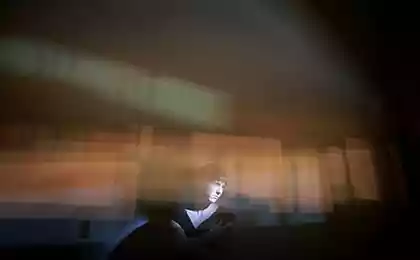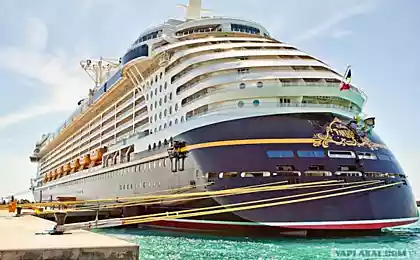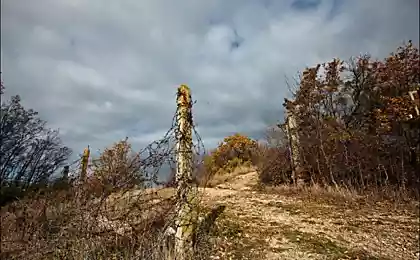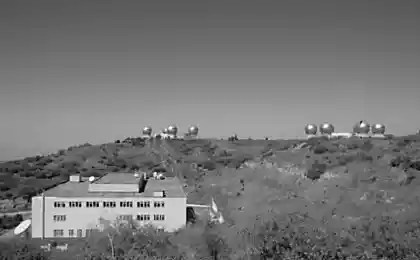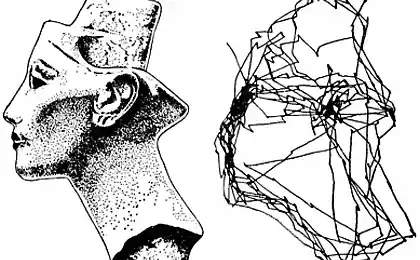942
On the strategic site at the window
Good afternoon dear YaPovtsy!
This topic will discuss the strategic site at the window
Originally wanted to use the "Live" photos, but a close friend (the officer carrying the service at this facility) is highly recommended, not to do so. Therefore, in this article I will use material from open sources.

1.
What a ridiculous question? "Contact with the submarine"? Get a satellite phone and call. Commercial satellite communications systems such as INMARSAT or "Iridium", allow the comfort of the Moscow office, to reach Antarctica. The only negative - the high cost of the call, however, at the Ministry of Defense and the Russian Space Agency, for sure, there are internal "corporate program" with a substantial discount ...
Indeed, in the age of the Internet, "Glonass" and wireless data communication problem with submarines may seem pointless and not very clever joke - what there can be problems later, 120 years after the invention of radio?
And the problem here is one - boat, unlike airplanes and ships, is moving in the depths of the ocean and did not respond to the call normal HF, VHF, LW radio stations - salt water, being an excellent electrolyte reliably suppresses any signals.
Well ... if need be - the boat can float to periscope depth, push the radio antenna and conduct a session with the shore. Problem solved?
Alas, not everything is so simple - modern nuclear submarines capable months in a submerged position, only occasionally rising to the surface for a planned session. The main importance of the issue is a reliable information transfer from the shore to the submarine: really important to translate the order will have to wait a day or more - until the next scheduled session?
In other words, at the start of a nuclear war missile submarines at risk of being useless - at a time when the surface will rattle fights boats continue to quietly write out "eight" in the depths of the oceans, unaware of the tragic events taking place "above". But what about our nuclear retaliation? Why naval nuclear forces, if they can not apply on time?
How can contact lurking submarine on the seabed?
The first method is quite logical and simple, while at the same time it is very difficult to implement in practice, and the range of the system leaves much to be desired. This is a sonar communication - acoustic waves, in contrast to the electromagnetic apply in the marine environment far better than air - the speed of sound at a depth of 100 meters is 1468 m / s!
We can only be installed on the bottom of the hydrophones or powerful explosive charges - a series of explosions at a certain interval clearly shows the need for submarines to emerge and take an important cryptogram on radio. The method is suitable for the operation in the coastal zone, but the "shout" the Pacific Ocean has not come out, otherwise the required power explosions exceed all reasonable limits, and formed a wave-tsunami washed away everything, from Moscow to New York.
2.Konechno, can be laid on the bottom of the hundreds and thousands of kilometers of cables - to the hydrophones installed in areas most likely to find the strategic missile nuclear submarines and multipurpose ... But there is another, more reliable and efficient solution?
Circumvent the laws of nature can not be, but in each of the rules there are exceptions. Surface of the sea is not transparent for the long, medium, short and ultra-short waves. At the same time, extra-long waves reflected from the ionosphere, can easily be extended beyond the horizon of thousands of kilometers and are able to penetrate into the depths of the oceans.
The yield found - Communication on the super-long waves. And a trivial issue communications with submarines solved! But why all radio amateurs and experts in the field of radio sitting with a sad expression on the faces?
The dependence of the penetration depth of radio waves from their frequency VLF (very low frequency) - very low frequency ELF (extremely low frequency) - extremely low frequency
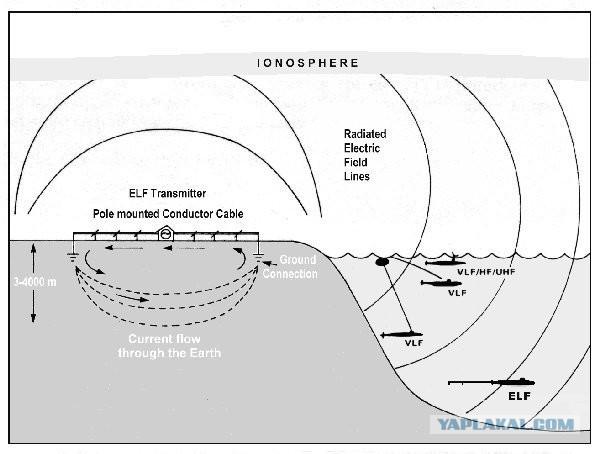
3.
Extra-long waves - radio waves with a wavelength of more than 10 km. In this case, we are interested in the range of very low frequency (VLF), between 3 and 30 kHz, the so-called "Miriametrovye wave." Do not even try to look for this range on your radios - to work with very long wave antenna need tremendous size, length of many kilometers - none of civil radio does not work in a range of "miriametrovyh waves».
The monstrous size antenna - this is the main catch to the creation of the VLF radio stations.
Yet, research in this area were carried out in the first half of XX century - the outcome was an incredible Der Goliath («Goliath"). Another representative of the German "vundervaffe" - the world's first superlong station created for the benefit of the Kriegsmarine. Signals "Goliath" confidently make submarines in the Cape of Good Hope, and the emitted super-transmitter radio waves can penetrate water to a depth of 30 meters.
Plan Kalbe / Milde and VLF radio Goliath

4.
Type "Goliath" staggering: VLF transmitter antenna is composed of three parts of the umbrella mounted around the three central pillars of the height of 210 meters, the angles of the antenna fixed on fifteen lattice masts the height of 170 meters. Each antenna web, in turn, is divided into six right triangles with a side of 400 is a system of steel wires in the moving aluminum shell. Pulling the antenna webs made 7-ton counterweights.
Maximum transmitter power - 1, 8 MW. Operating range 15 - 60 kHz, the wavelength of 5,000 - 20,000 m. The data transfer rate - up to 300 bit / s.
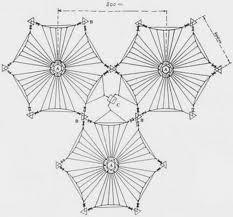
5.
City Kyalbe 1943
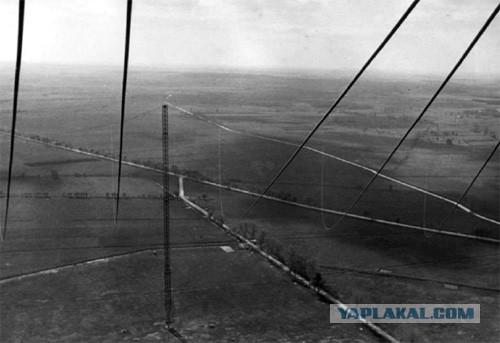
6.
City Kyalbe 1943
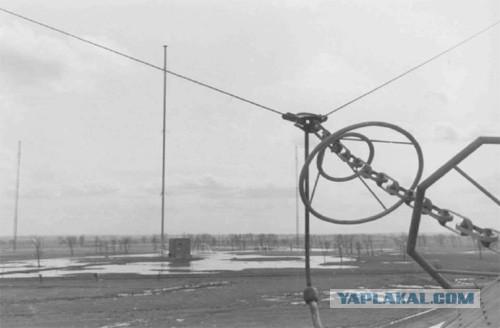
7.
Installation grand station in the suburbs of Kalbe was completed in the spring of 1943 in the construction of forced labor was widely used by Soviet and French prisoners of war. Fortunately, the concentration camp was not far away, in the nearby town Gardelengen.
Prisoners of war paved the trenches for underground cables. According to the recollections of witnesses, residents of Kalbe / Milde, the prisoners were very hungry, picked up from the ground all edible, even ate the grass. The first Soviet prisoners began arriving at the construction of the "Goliath" in September 1941. They were brought by rail directly from the Soviet - German front in cattle cars. When you open the doors of the cars of the first echelon of Soviet prisoners of war found that of the approximately 300 prisoners 8 people have already died, and others were inoperable. Deceased prisoners were buried outside the cemetery Altmersleben without registration.
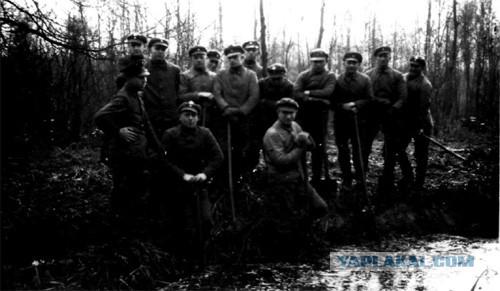
8.
. Two years "Goliath" served the interests of the Kriegsmarine, coordinating the actions of "wolf packs" on the expanse of the Atlantic, up until April 1945 in the "object" was captured by US troops. After some time, the area came under the control of the Soviet administration - station immediately dismantled and taken to the Soviet Union.
From photographic archive Henning Kruger №05505-22. Soviet prisoners of war in the construction of the station Goliath. In the foreground - the guards of prisoners of war.

9.
Sixty years Germans guessing where the Russian hid "Goliath." Did these barbarians allowed masterpiece of German design ideas on the nails? The mystery opened at the beginning of the XXI century - German newspapers came out with headlines: "Sensation! "Goliath" found! The station is still in working condition!
Location towers on the territory of the military unit
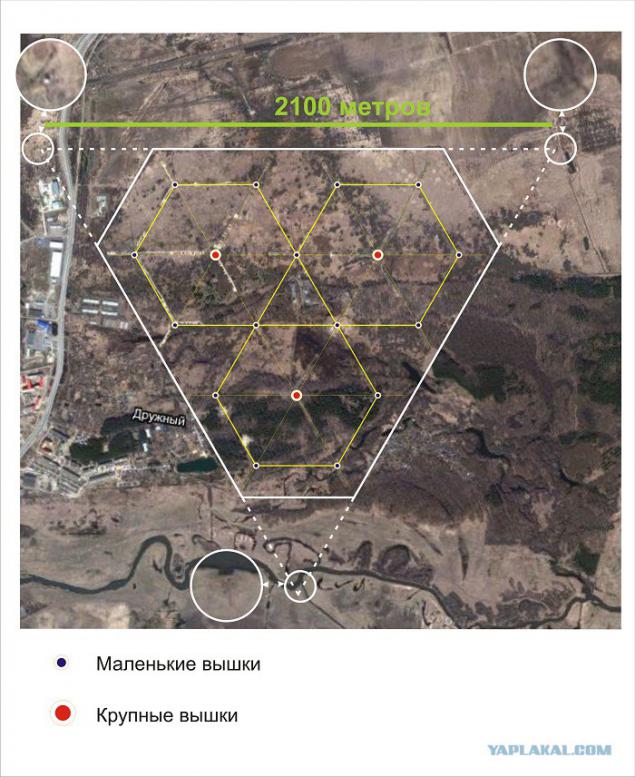
10.
Tall mast "Goliath" leaped skyward in Kstovo district of Nizhny Novgorod region, near the village of everybody - from here is broadcasting captured the super-transmitter. The decision on the restoration of "Goliath" was made back in 1949, first airing took place December 27, 1952. And now, more than 60 years the legendary "Goliath" is the guardian of our Fatherland, providing a link to reaching submerged submarines of the Navy, as both a transmitter the exact time service "Beta».
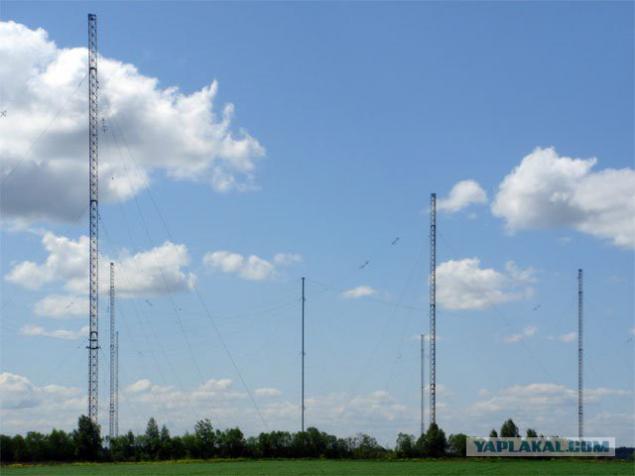
11.
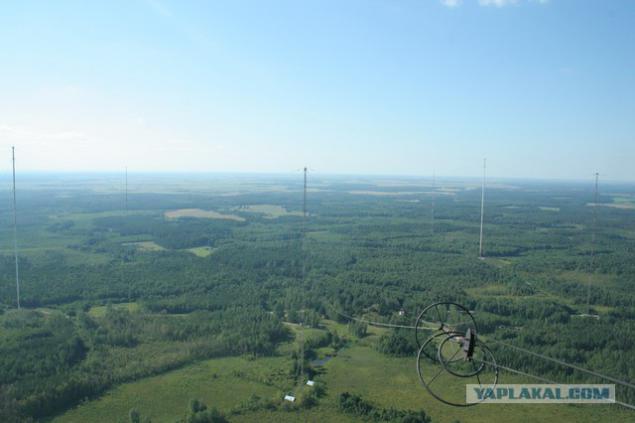
12.
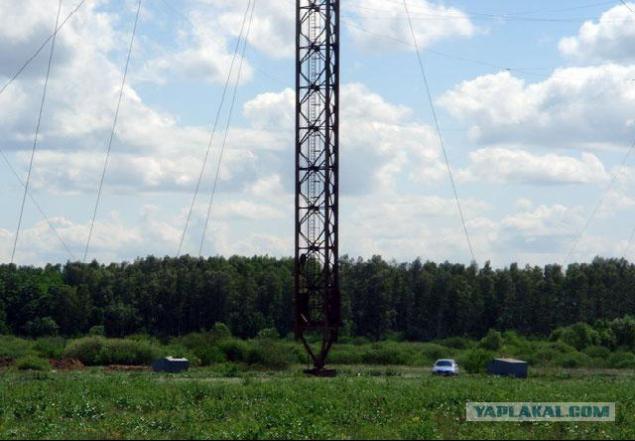
13.
Communication Center.
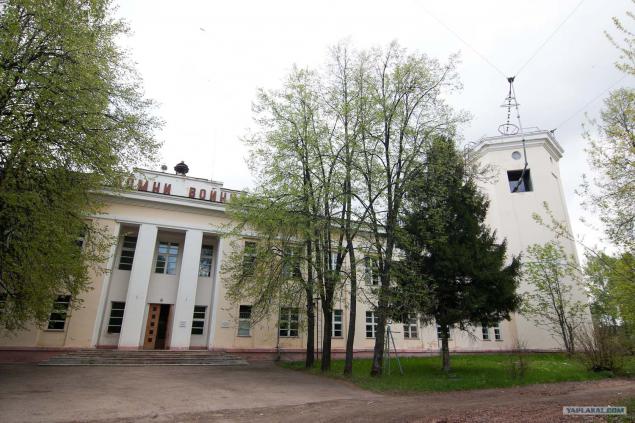
14.
The central mast. 210 m. Khaljavnogo Wi-Fi in speeds of up to 300Mbps / s.
Posted in [mergetime] 1394112684 [/ mergetime]
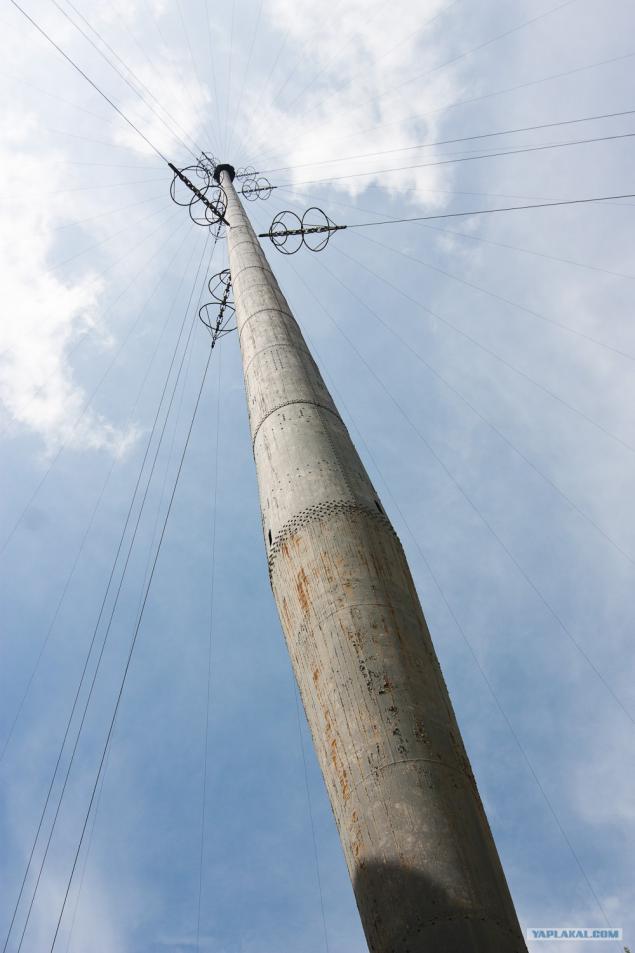
Source:
This topic will discuss the strategic site at the window
Originally wanted to use the "Live" photos, but a close friend (the officer carrying the service at this facility) is highly recommended, not to do so. Therefore, in this article I will use material from open sources.

1.
What a ridiculous question? "Contact with the submarine"? Get a satellite phone and call. Commercial satellite communications systems such as INMARSAT or "Iridium", allow the comfort of the Moscow office, to reach Antarctica. The only negative - the high cost of the call, however, at the Ministry of Defense and the Russian Space Agency, for sure, there are internal "corporate program" with a substantial discount ...
Indeed, in the age of the Internet, "Glonass" and wireless data communication problem with submarines may seem pointless and not very clever joke - what there can be problems later, 120 years after the invention of radio?
And the problem here is one - boat, unlike airplanes and ships, is moving in the depths of the ocean and did not respond to the call normal HF, VHF, LW radio stations - salt water, being an excellent electrolyte reliably suppresses any signals.
Well ... if need be - the boat can float to periscope depth, push the radio antenna and conduct a session with the shore. Problem solved?
Alas, not everything is so simple - modern nuclear submarines capable months in a submerged position, only occasionally rising to the surface for a planned session. The main importance of the issue is a reliable information transfer from the shore to the submarine: really important to translate the order will have to wait a day or more - until the next scheduled session?
In other words, at the start of a nuclear war missile submarines at risk of being useless - at a time when the surface will rattle fights boats continue to quietly write out "eight" in the depths of the oceans, unaware of the tragic events taking place "above". But what about our nuclear retaliation? Why naval nuclear forces, if they can not apply on time?
How can contact lurking submarine on the seabed?
The first method is quite logical and simple, while at the same time it is very difficult to implement in practice, and the range of the system leaves much to be desired. This is a sonar communication - acoustic waves, in contrast to the electromagnetic apply in the marine environment far better than air - the speed of sound at a depth of 100 meters is 1468 m / s!
We can only be installed on the bottom of the hydrophones or powerful explosive charges - a series of explosions at a certain interval clearly shows the need for submarines to emerge and take an important cryptogram on radio. The method is suitable for the operation in the coastal zone, but the "shout" the Pacific Ocean has not come out, otherwise the required power explosions exceed all reasonable limits, and formed a wave-tsunami washed away everything, from Moscow to New York.
2.Konechno, can be laid on the bottom of the hundreds and thousands of kilometers of cables - to the hydrophones installed in areas most likely to find the strategic missile nuclear submarines and multipurpose ... But there is another, more reliable and efficient solution?
Circumvent the laws of nature can not be, but in each of the rules there are exceptions. Surface of the sea is not transparent for the long, medium, short and ultra-short waves. At the same time, extra-long waves reflected from the ionosphere, can easily be extended beyond the horizon of thousands of kilometers and are able to penetrate into the depths of the oceans.
The yield found - Communication on the super-long waves. And a trivial issue communications with submarines solved! But why all radio amateurs and experts in the field of radio sitting with a sad expression on the faces?
The dependence of the penetration depth of radio waves from their frequency VLF (very low frequency) - very low frequency ELF (extremely low frequency) - extremely low frequency

3.
Extra-long waves - radio waves with a wavelength of more than 10 km. In this case, we are interested in the range of very low frequency (VLF), between 3 and 30 kHz, the so-called "Miriametrovye wave." Do not even try to look for this range on your radios - to work with very long wave antenna need tremendous size, length of many kilometers - none of civil radio does not work in a range of "miriametrovyh waves».
The monstrous size antenna - this is the main catch to the creation of the VLF radio stations.
Yet, research in this area were carried out in the first half of XX century - the outcome was an incredible Der Goliath («Goliath"). Another representative of the German "vundervaffe" - the world's first superlong station created for the benefit of the Kriegsmarine. Signals "Goliath" confidently make submarines in the Cape of Good Hope, and the emitted super-transmitter radio waves can penetrate water to a depth of 30 meters.
Plan Kalbe / Milde and VLF radio Goliath

4.
Type "Goliath" staggering: VLF transmitter antenna is composed of three parts of the umbrella mounted around the three central pillars of the height of 210 meters, the angles of the antenna fixed on fifteen lattice masts the height of 170 meters. Each antenna web, in turn, is divided into six right triangles with a side of 400 is a system of steel wires in the moving aluminum shell. Pulling the antenna webs made 7-ton counterweights.
Maximum transmitter power - 1, 8 MW. Operating range 15 - 60 kHz, the wavelength of 5,000 - 20,000 m. The data transfer rate - up to 300 bit / s.

5.
City Kyalbe 1943

6.
City Kyalbe 1943

7.
Installation grand station in the suburbs of Kalbe was completed in the spring of 1943 in the construction of forced labor was widely used by Soviet and French prisoners of war. Fortunately, the concentration camp was not far away, in the nearby town Gardelengen.
Prisoners of war paved the trenches for underground cables. According to the recollections of witnesses, residents of Kalbe / Milde, the prisoners were very hungry, picked up from the ground all edible, even ate the grass. The first Soviet prisoners began arriving at the construction of the "Goliath" in September 1941. They were brought by rail directly from the Soviet - German front in cattle cars. When you open the doors of the cars of the first echelon of Soviet prisoners of war found that of the approximately 300 prisoners 8 people have already died, and others were inoperable. Deceased prisoners were buried outside the cemetery Altmersleben without registration.

8.
. Two years "Goliath" served the interests of the Kriegsmarine, coordinating the actions of "wolf packs" on the expanse of the Atlantic, up until April 1945 in the "object" was captured by US troops. After some time, the area came under the control of the Soviet administration - station immediately dismantled and taken to the Soviet Union.
From photographic archive Henning Kruger №05505-22. Soviet prisoners of war in the construction of the station Goliath. In the foreground - the guards of prisoners of war.

9.
Sixty years Germans guessing where the Russian hid "Goliath." Did these barbarians allowed masterpiece of German design ideas on the nails? The mystery opened at the beginning of the XXI century - German newspapers came out with headlines: "Sensation! "Goliath" found! The station is still in working condition!
Location towers on the territory of the military unit

10.
Tall mast "Goliath" leaped skyward in Kstovo district of Nizhny Novgorod region, near the village of everybody - from here is broadcasting captured the super-transmitter. The decision on the restoration of "Goliath" was made back in 1949, first airing took place December 27, 1952. And now, more than 60 years the legendary "Goliath" is the guardian of our Fatherland, providing a link to reaching submerged submarines of the Navy, as both a transmitter the exact time service "Beta».

11.

12.

13.
Communication Center.

14.
The central mast. 210 m. Khaljavnogo Wi-Fi in speeds of up to 300Mbps / s.
Posted in [mergetime] 1394112684 [/ mergetime]

Source:
